Why Is The Masters A Major?
Why is The Masters a Major? It is largely because Arnold Palmer and the journalist Bob Drum in 1960 decided it was. Yup, it is a simple as that. Well sort of. But if you want the more detailed version...


Why Is The Masters A Major?
Why is The Masters A Major? On the face of it, The Masters is the odd one out of the Majors in so many ways. How does a private club’s own invitational competition with a small field and run by an elitist, secretive, private club get to stand alongside open events run by golf’s governing bodies as one of the four ‘Major’ golf tournaments?
The term Major used not to exist, well not as noun for a golf tournament. We now say that Bobby Jones won seven Majors, but that is a retrospective judgement. No-one was saying that when he was actually winning them. In 1930 Jones won The Open Championship and The Amateur Championship, at Royal Liverpool and St Andrews respectively, and then the US Open and US Amateur in his native land. These were seen as the four most prestigious tournaments in world golf at the time.
Bobby Jones was a lawyer who played as an amateur, However he also made money from golf-related activities. Not least from the 50-1 bet he placed before that 1930 season that he would win The Open Championship and The Amateur Championship, at Royal Liverpool and St Andrews respectively, and then the US Open and US Amateur. When he did so, he won $60,000 and retired from competitive golf.
But what to call his 1930 quartet of victories? Atlanta Journal’s OB Keeler, adopting a Bridge term, described it as “the Grand Slam”. George Trevor of the New York Sun wrote of Jones’ triumph in the US Amateur that, “This victory, the fourth major title in the same season and in the space of four months, had now and for all time entrenched Bobby Jones safely within the ‘Impregnable Quadrilateral of Golf’, that granite fortress he alone could take by escalade, and that others may attack in vain, forever.”
He was right on the last part. No professional could match Jones' four victories, as two of the events were only for amateurs. No amateur was likely to match it either, as the US Open and The Open Championship had fallen into a pattern of being won by professionals. Jones’ win in 1930 was the sixth and last by an amateur at The Open, and three years later John Goodman became the last of the five amateurs to have won the US Open.
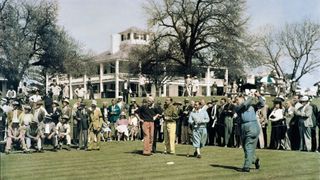
Bobby Jones drives from the first tee during the 1935 Masters while (from left) Tommy Armour, Walter Hagen and Gene Sarazen watch on.
While flying to Ireland for the Canada Cup in 1960, from where they would go on to St Andrews for The Open Championship, Arnold Palmer and the journalist Bob Drum got to discussing what a contemporary version of Jones’ Grand Slam might look like.
The Open Championship and US Open remained, but what would replace the two amateur events? The annual tournament of the Professional Golfers' Association of America was an obvious candidate. But what would be the fourth one?
Get the Golf Monthly Newsletter
Subscribe to the Golf Monthly newsletter to stay up to date with all the latest tour news, equipment news, reviews, head-to-heads and buyer’s guides from our team of experienced experts.
Well, The Masters was the event with the most prize money – that year, the winner, Palmer himself, had received $17,000, compared with $14,400 for triumphing at the US Open. So Palmer nominated The Masters alongside the US PGA Championship. Drum liked the idea and wrote about this quartet of tournaments comprising golf’s new Grand Slam.
“One thing led to another,” Palmer later recalled. “Drum got the British press all excited about it. Everybody picked up on it at St Andrews that year.” Mark McCormack, Palmer’s agent, certainly did. His client had already won The Masters and US Open that year, so was halfway to achieving this new Grand Slam.
Few Americans travelled to compete in The Open at that time. Palmer, now 30 and with 19 PGA Tour wins, had not done so before. His participation caused a stir, and it was hyped up with the narrative of him going for this modern Grand Slam. The fact it was the centenary of The Open Championship only added to the romance and drama.
He was tied for 4th after the first round and tied for 3rd after both the second and third rounds. On the final day, Palmer was unable to haul in Australian Kel Nagle’s four-shot overnight lead and finished runner-up by a single shot. Palmer was never able to win a Grand Slam, nor indeed a Career Grand Slam, as the USPGA always eluded him. But he did create one.
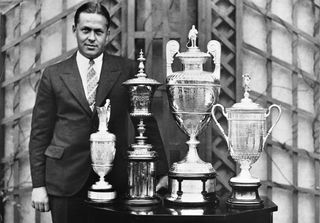
Bobby Jones with his Grand Slam trophies in 1930.
Augusta National had wanted to host the US Open instead
Had things been different, Augusta National would still have hosted a Major, but it would have been the US Open. That was the wish of the founders when they were creating their course. But the US Open is held in June and Georgia was oppressively hot then, so the United States Golf Association said thanks but no thanks.
So, unable to host the US Open, the club created its own competition. For the Spring, when it is cooler.
It was not initially a success. In the early years, the Augusta National Invitational Tournament – as The Masters was first known – was a little-regarded event held by a private club in desperate financial straits struggling to survive.
This was not how it was meant to be. The idea of the club’s two founders, New York investment banker Clifford Roberts and Bobby Jones, one of the greatest golfers of all time, had been to create a club for the rich elite which would host the US Open, have two 18-hole courses, 1,800 members and homes built on the site. None of these four things came to pass.
Augusta had for decades been a popular winter destination for wealthy north-easterners, and the club had aimed to carve out a part of that market for itself – hence the National part of its name. It was not to be a locale for the locals.

Augusta was founded by Bobby Jones and Clifford Roberts in 1933. (Photo by The Print Collector/Print Collector/Getty Images)
The club had bought the land cheap from a hotel chain, which had purchased it from a plant nursery that closed in 1925. The plan had been to construct a hotel there, but the hoteliers ran out of money to do so, and ended up selling the land for a third of what they paid for it.
The club also struggled to raise the money to build what it had intended. It managed to build one course, although it defaulted in paying Alister MacKenzie, who died without remuneration for his most famous design.
It also had no money itself to put up as the prize for it new competition, so it passed the hat around its members. But even then it failed to produce the requisite sum. Part of the problem was that rather than having 1,800 members as planned, it had 76.
The club had opened in December 1932 during the Great Depression in the aftermath of the stock-market crash of 1929. Not only were there now fewer wealthy businessmen to attract to the club, but fashions were changing and Augusta was being superseded by Florida as a holiday destination for the elite.
So that the inaugural Augusta National Invitational Tournament could be held in 1934, the City of Augusta council gave the club $10,000 in the hope that the tournament would boost the city’s profile and declining tourist industry. It was estimated that 20,000 people would come to watch the tournament, pumping $1million into the local economy. In the end, only about 1,000 came each day.
Prize money was important in securing prestige for the event. A combination of Bobby Jones‘ name and contacts and the lure of big bucks ensured a high-quality field. The winner of the first tournament, Horton Smith, got $1,500; in comparison, the champions of the US Open and USPGA in 1934 took home $1,000.
The media were also courted. For many years, selected journalists had their travelling expenses paid by the club to encourage them to report on the tournament.
Bobby Jones came out of competitive retirement to give a story for the media for that first tournament and continued in a ceremonial playing role until 1948. Newspaper reports focused as much on how Jones was doing – he finished 13th in the 60-man field, ten shots behind – as to who was leading it. Shades of how some events with TIger Woods in them would later be reported.
But with the event failing to attract spectators to Augusta, the hoped-for boost to the local economy hadn’t materialised. Next year, the council would only put up $7,500 – and handed over only $5,000 of it as it deducted $2,500 to cover a water bill the club had twice defaulted in paying.
The following year, the council delayed a decision on funding the tournament. Its staging was announced only three months before the event, once funding had been agreed. But this was the last time public money was provided. There simply wasn’t the return on the investment and the club’s secrecy as to how it spent this public money also rankled.
Even fewer people came in 1938. Rather than grow a spectator base, the club seemed to be shrinking it. Without either public money or much revenue from ticket sales, the tournament’s future looked bleak.
But a local businessman had big plans for promoting The Masters as the tournament was renamed in 1939. Alvin M. McAuliffe formed the Business Men’s Masters Tournament Association to sell tickets through local businesses. By the following year the Association had doubled ticket sales. Yet again the locals had come to the aid of this exclusive club for the rich from the other American states.
Yet for decades still the tournament did not attract huge crowds. It was not until 1966 that it had its first ‘sell-out’. But by then, The Masters was a Major thanks to Messrs Drum and Palmer. Well, them and the large amount of prize money.
Contributing Writer Golf courses and travel are Roderick’s particular interests and he was contributing editor for the first few years of the Golf Monthly Travel Supplement. He writes travel articles and general features for the magazine, travel supplement and website. He also compiles the magazine's crossword. He is a member of Trevose Golf & Country Club and has played golf in around two dozen countries. Cricket is his other main sporting love. He is the author of five books, four of which are still in print: The Novel Life of PG Wodehouse; The Don: Beyond Boundaries; Wally Hammond: Gentleman & Player and England’s Greatest Post-War All Rounder.
-
 'Gator Netting Is In Place' - Chevron Championship Venue Prepared For 'Safe' Winner's Jump
'Gator Netting Is In Place' - Chevron Championship Venue Prepared For 'Safe' Winner's JumpA tradition which began at the tournament's previous home could continue this year - if the champion is feeling brave enough...
By Jonny Leighfield Published
-
 New Balance 997 SL Golf Shoe Review
New Balance 997 SL Golf Shoe ReviewNew Balance produce some extremely stylish footwear and, in this review, Matt Cradock takes their spikeless 997 SL onto the course
By Matt Cradock Published
-
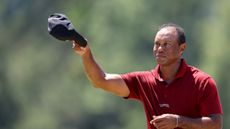 Why Tiger Woods’ Masters Week Was Actually A Huge Success
Why Tiger Woods’ Masters Week Was Actually A Huge SuccessWoods finished last at an event in which he made the cut for just the third time in his near-30-year pro career at The 2024 Masters - but looking at the result here is too short-sighted...
By Jonny Leighfield Published
-
 What Golf Shoe Does Bryson Dechambeau Wear?
What Golf Shoe Does Bryson Dechambeau Wear?DeChambeau has worn many pairs of golf shoes throughout his career, with the American currently wearing the FootJoy HyperFlex Carbon
By Matt Cradock Published
-
 The Masters Azalea Cocktail Recipe: How To Make The Famous Augusta National Drink
The Masters Azalea Cocktail Recipe: How To Make The Famous Augusta National DrinkThanks to the Masters’ official pinterest page, we now know how to make the famous cocktail the right way
By Joel Kulasingham Published
-
 The 2018 Fairway Wood Tiger Woods Is Using At The Masters
The 2018 Fairway Wood Tiger Woods Is Using At The MastersDespite being an older model, the 15-time Major winner has kept the TaylorMade M3 fairway wood in his bag for over six years and continues to use it at Augusta National
By Matt Cradock Published
-
 What Golf Shoes Is Camilo Villegas Wearing At The Masters?
What Golf Shoes Is Camilo Villegas Wearing At The Masters?The multiple-time PGA Tour winner was seen wearing a pair of eye-catching Nike Air Jordan shoes whilst paired with Rory McIlroy during the third round at Augusta National
By Matt Cradock Published
-
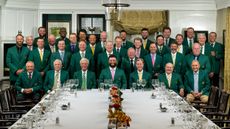 Who Has Won The Most Money At The Masters?
Who Has Won The Most Money At The Masters?Jack Nicklaus has won the most Green Jackets in history and Tiger Woods is the most successful champion in the modern era - but the answer is neither of those two...
By Jonny Leighfield Published
-
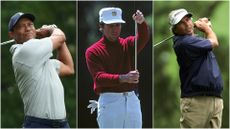 Who Has Made The Most Consecutive Cuts At The Masters?
Who Has Made The Most Consecutive Cuts At The Masters?Tiger Woods is chasing a record-breaking 25th consecutive cut at the 2024 Masters
By Joel Kulasingham Published
-
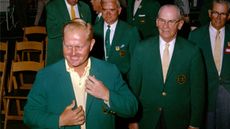 Who Gives The Green Jacket If There's A Back-To-Back Winner Of The Masters?
Who Gives The Green Jacket If There's A Back-To-Back Winner Of The Masters?Traditionally, the previous winner of The Masters hands the new champion the Green Jacket - here's what happens when there's a back-to-back winner
By Mike Hall Published